Plant Science Research Weekly: June 11, 2021
Focus Issue: Focus on the Biology of Plant Genomes
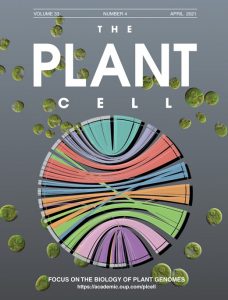 The Plant Cell has published a Focus Issue on the Biology of Plant Genomes. This Focus Issue includes reviews and research articles that highlight some of the most important recent advances in plant genomics and foreshadow future discoveries. Although Arabidopsis is represented in this article collection (with articles focused on NLR proteins and CRISPR screening), most of the articles are focused on genomes beyond this well-established model – including Populus, maize, Brachypodium, Clamydomonas and others. As a bonus, four authors recently highlighted their contributions to this special focus issue through a set of short talks, available here (Ksenia Krasileva, Christine Diepenbrock, and Rory Craig) and here (Jim Birchler, Evan Forsythe, and Tom Jacobs). (Summary by Mary Williams @PlantTeaching) The Plant Cell, Vol. 33, Issue 4.
The Plant Cell has published a Focus Issue on the Biology of Plant Genomes. This Focus Issue includes reviews and research articles that highlight some of the most important recent advances in plant genomics and foreshadow future discoveries. Although Arabidopsis is represented in this article collection (with articles focused on NLR proteins and CRISPR screening), most of the articles are focused on genomes beyond this well-established model – including Populus, maize, Brachypodium, Clamydomonas and others. As a bonus, four authors recently highlighted their contributions to this special focus issue through a set of short talks, available here (Ksenia Krasileva, Christine Diepenbrock, and Rory Craig) and here (Jim Birchler, Evan Forsythe, and Tom Jacobs). (Summary by Mary Williams @PlantTeaching) The Plant Cell, Vol. 33, Issue 4.
Review: Auxin fluxes through plasmodesmata
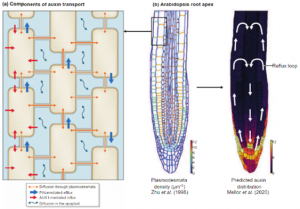 Plasmodesmata, the tubular connections that form continua between neighboring cells in plants, play vital roles in long-distance transport of ions, RNA, proteins, and small molecules. While it is known that plasmodesmata are permeable to phytohormones, including auxin, the physiological significance of plasmodesmata-mediated auxin transport remains underappreciated. Though carrier-mediated transport is considered to be the primary mode of transport for cellular auxin signaling, mathematical modelling studies have found auxin diffusion through plasmodesmata to compare with carrier-mediated velocity of auxin transport. Thus, plasmodesmatal auxin permeability might complement carrier-mediated auxin distribution to maintain cellular auxin homeostasis. As would be expected, such auxin diffusion is regulated by plasmodesmal callose deposition and interestingly, this callose modulation is essential for key auxin-controlled processes of phototropism and lateral root development. However, it is still unclear if auxin regulates its own transport through the plasmodesmata in a feedback regulation, as has been previously known in carrier-mediated auxin transport processes. This review from Leah Band is thus important in highlighting a process that needs deeper study and which will provide a substantial addition to our knowledge of auxin biology. (Summary by Pavithran Narayanan @pavi_narayanan). New Phytol. 10.1111/nph.17517
Plasmodesmata, the tubular connections that form continua between neighboring cells in plants, play vital roles in long-distance transport of ions, RNA, proteins, and small molecules. While it is known that plasmodesmata are permeable to phytohormones, including auxin, the physiological significance of plasmodesmata-mediated auxin transport remains underappreciated. Though carrier-mediated transport is considered to be the primary mode of transport for cellular auxin signaling, mathematical modelling studies have found auxin diffusion through plasmodesmata to compare with carrier-mediated velocity of auxin transport. Thus, plasmodesmatal auxin permeability might complement carrier-mediated auxin distribution to maintain cellular auxin homeostasis. As would be expected, such auxin diffusion is regulated by plasmodesmal callose deposition and interestingly, this callose modulation is essential for key auxin-controlled processes of phototropism and lateral root development. However, it is still unclear if auxin regulates its own transport through the plasmodesmata in a feedback regulation, as has been previously known in carrier-mediated auxin transport processes. This review from Leah Band is thus important in highlighting a process that needs deeper study and which will provide a substantial addition to our knowledge of auxin biology. (Summary by Pavithran Narayanan @pavi_narayanan). New Phytol. 10.1111/nph.17517
Pan-genome analysis of 33 genetically diverse rice accessions reveals hidden genomic variations
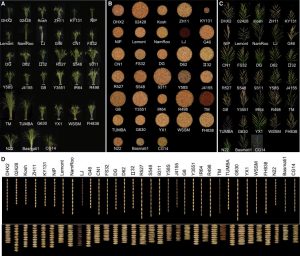 In spite of the considerable excitement that accompanies the first genomic sequence of a species, that sequence usually represents a single individual or inbred accession – the real excitement comes from comparisons between individuals or accessions. These pan-genomic analyses provide insights into the sources of genetic variability. Here, Qin et al. compare the genomes of 33 diverse rice accessions: 32 Orzya sativa and 1 Oryza glaberrima, African cultivated rice, which was domesticated independently and serves as an outgroup to help to identify ancestral versus derived variations. This comparative analysis demonstrated numerous Structural Variations (SVs) including Presence/Absence Variations (PAVs), as well as gene Copy Number Variations (gCNVs). Both SVs and gCNVs are correlated with variations in gene expression levels and agronomic traits. The authors produced a graph-based genome that includes the full genetic diversity from these diverse accessions, providing a rich and powerful dataset that can be browsed here http://ricerc.sicau.edu.cn/. (Summary by Mary Williams @PlantTeaching) Cell 10.1016/j.cell.2021.04.046
In spite of the considerable excitement that accompanies the first genomic sequence of a species, that sequence usually represents a single individual or inbred accession – the real excitement comes from comparisons between individuals or accessions. These pan-genomic analyses provide insights into the sources of genetic variability. Here, Qin et al. compare the genomes of 33 diverse rice accessions: 32 Orzya sativa and 1 Oryza glaberrima, African cultivated rice, which was domesticated independently and serves as an outgroup to help to identify ancestral versus derived variations. This comparative analysis demonstrated numerous Structural Variations (SVs) including Presence/Absence Variations (PAVs), as well as gene Copy Number Variations (gCNVs). Both SVs and gCNVs are correlated with variations in gene expression levels and agronomic traits. The authors produced a graph-based genome that includes the full genetic diversity from these diverse accessions, providing a rich and powerful dataset that can be browsed here http://ricerc.sicau.edu.cn/. (Summary by Mary Williams @PlantTeaching) Cell 10.1016/j.cell.2021.04.046
Waves of information: Simultaneous imaging of ER and cytosolic Ca2+ dynamics reveals long distance ER Ca2+ waves in plants
 Calcium (Ca2+) signaling regulates a host of stress and developmental responses in plants. Apart from increases in cytosolic Ca2+ concentration ([Ca2+]Cyt.), organellar signals play a key role in shaping the cytosolic signaling events. In an attempt to understand the Ca2+ dynamics in the endoplasmic reticulum (ER), Resentini and colleagues analyzed Ca2+ signaling simultaneously in the ER and cytosol using two intensiometric Ca2+ biosensors localized to the two compartments. Application of adenosine triphosphate (ATP) and naphthalene acetic acid (NAA) generated ER Ca2+ signals in single cells that temporally succeeded cytosolic signals with a lag of about 5 secs. Interestingly, treatment with cyclopiazonic acid (CPA), a specific inhibitor of ER Ca2+-ATPases, resulted in a significant dip in [Ca2+]ER, with a concomitant increase in [Ca2+]Cyt., implying a continuous, ER-type Ca2+-ATPases (ECA)-mediated transport of Ca2+ from the cytosol to the ER lumen. Leaf wounding in a soil-grown plant produced travelling Ca2+ waves in the ER that followed the well-studied cytosolic Ca2+ waves at both local as well as distal leaves. This work underscores the need to simultaneous measure Ca2+ signaling events in different subcellular compartments to better appreciate the complexities underlying cellular Ca2+ signaling. (Summary by Pavithran Narayanan @pavi_narayanan). Plant Physiology. 10.1093/plphys/kiab251
Calcium (Ca2+) signaling regulates a host of stress and developmental responses in plants. Apart from increases in cytosolic Ca2+ concentration ([Ca2+]Cyt.), organellar signals play a key role in shaping the cytosolic signaling events. In an attempt to understand the Ca2+ dynamics in the endoplasmic reticulum (ER), Resentini and colleagues analyzed Ca2+ signaling simultaneously in the ER and cytosol using two intensiometric Ca2+ biosensors localized to the two compartments. Application of adenosine triphosphate (ATP) and naphthalene acetic acid (NAA) generated ER Ca2+ signals in single cells that temporally succeeded cytosolic signals with a lag of about 5 secs. Interestingly, treatment with cyclopiazonic acid (CPA), a specific inhibitor of ER Ca2+-ATPases, resulted in a significant dip in [Ca2+]ER, with a concomitant increase in [Ca2+]Cyt., implying a continuous, ER-type Ca2+-ATPases (ECA)-mediated transport of Ca2+ from the cytosol to the ER lumen. Leaf wounding in a soil-grown plant produced travelling Ca2+ waves in the ER that followed the well-studied cytosolic Ca2+ waves at both local as well as distal leaves. This work underscores the need to simultaneous measure Ca2+ signaling events in different subcellular compartments to better appreciate the complexities underlying cellular Ca2+ signaling. (Summary by Pavithran Narayanan @pavi_narayanan). Plant Physiology. 10.1093/plphys/kiab251
Effect of nitrogen addition on selection of germination trait in an alpine meadow on the Tibet Plateau
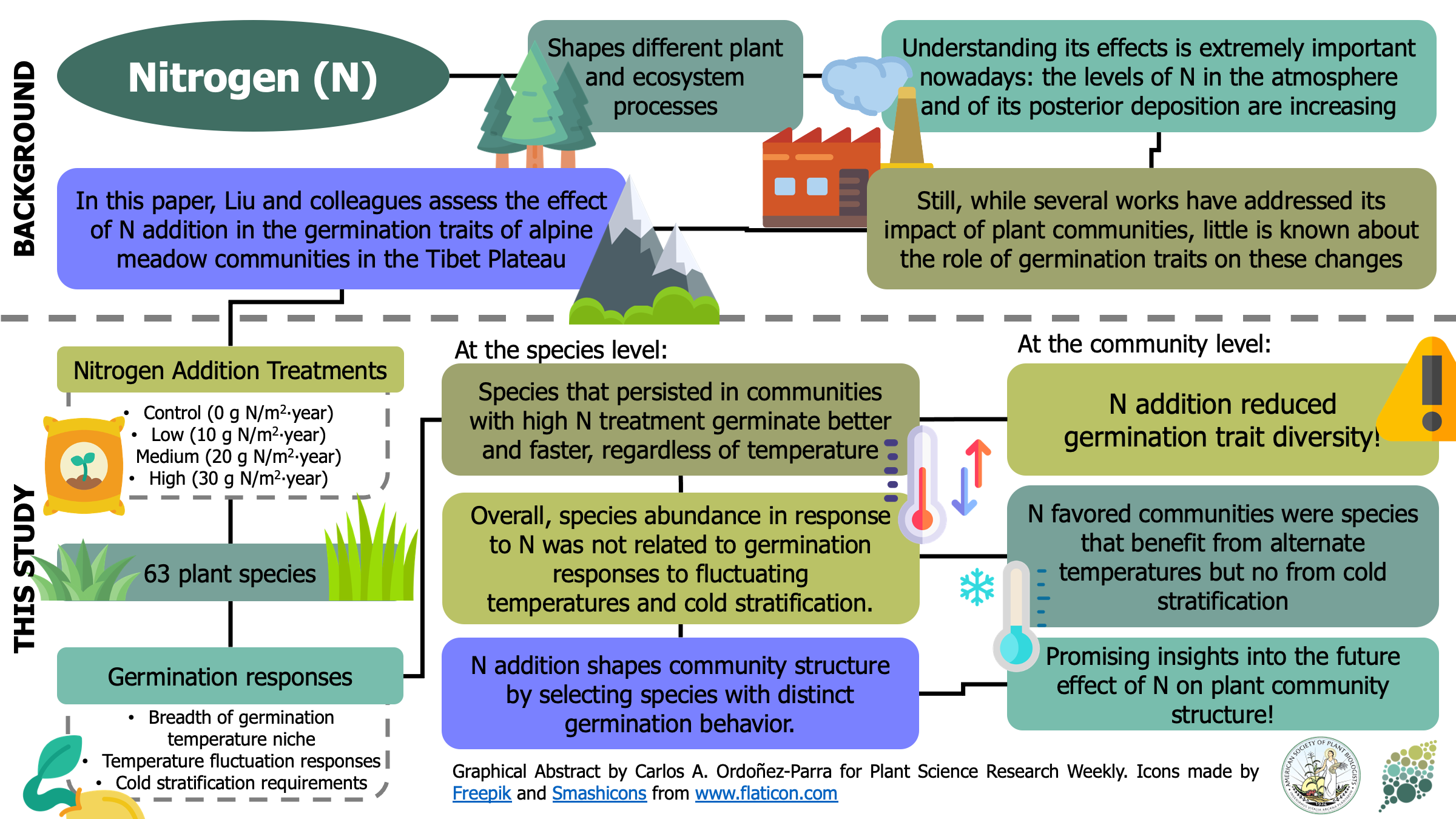 Considering that atmospheric nitrogen (N) and N deposition have increased due to human activities, understanding the effects of this element in plant communities has become increasingly important. Still, the role of germination traits in these changes at the community level is poorly understood. Here, Liu and colleagues assess the effects of N addition on the germination traits of alpine meadows in the Tibet Plateau. The vegetation of plots submitted to four N addition treatments (0, 10, 20 or 30 g N/m2∙year) for three years was monitored. The germination of 63 species was analyzed in terms of the range of germination temperatures, germination responses to temperature fluctuations and cold stratification requirements. Species that persisted in environments with high N addition tended to germinate better and faster in a broad range of temperatures. Still, changes in species abundance between treatments were unrelated to alternate temperature and cold stratification requirements. However, at the community level, N addition was associated with less diversity of germination traits, and high N addition favored species dependent on fluctuating temperatures and fewer species with cold stratification requirements. Consequently, this research provides robust evidence about how N addition favors distinct germination strategies and offers exciting insights into how communities will respond to increasing N availability. (Summary by Carlos A. Ordóñez-Parra @caordonezparra) Front. Plant Sci. 10.3389/fpls.2020.599496
Considering that atmospheric nitrogen (N) and N deposition have increased due to human activities, understanding the effects of this element in plant communities has become increasingly important. Still, the role of germination traits in these changes at the community level is poorly understood. Here, Liu and colleagues assess the effects of N addition on the germination traits of alpine meadows in the Tibet Plateau. The vegetation of plots submitted to four N addition treatments (0, 10, 20 or 30 g N/m2∙year) for three years was monitored. The germination of 63 species was analyzed in terms of the range of germination temperatures, germination responses to temperature fluctuations and cold stratification requirements. Species that persisted in environments with high N addition tended to germinate better and faster in a broad range of temperatures. Still, changes in species abundance between treatments were unrelated to alternate temperature and cold stratification requirements. However, at the community level, N addition was associated with less diversity of germination traits, and high N addition favored species dependent on fluctuating temperatures and fewer species with cold stratification requirements. Consequently, this research provides robust evidence about how N addition favors distinct germination strategies and offers exciting insights into how communities will respond to increasing N availability. (Summary by Carlos A. Ordóñez-Parra @caordonezparra) Front. Plant Sci. 10.3389/fpls.2020.599496
Comparative analyses of extreme dry seed thermotolerance in five Cactaceae species ($)
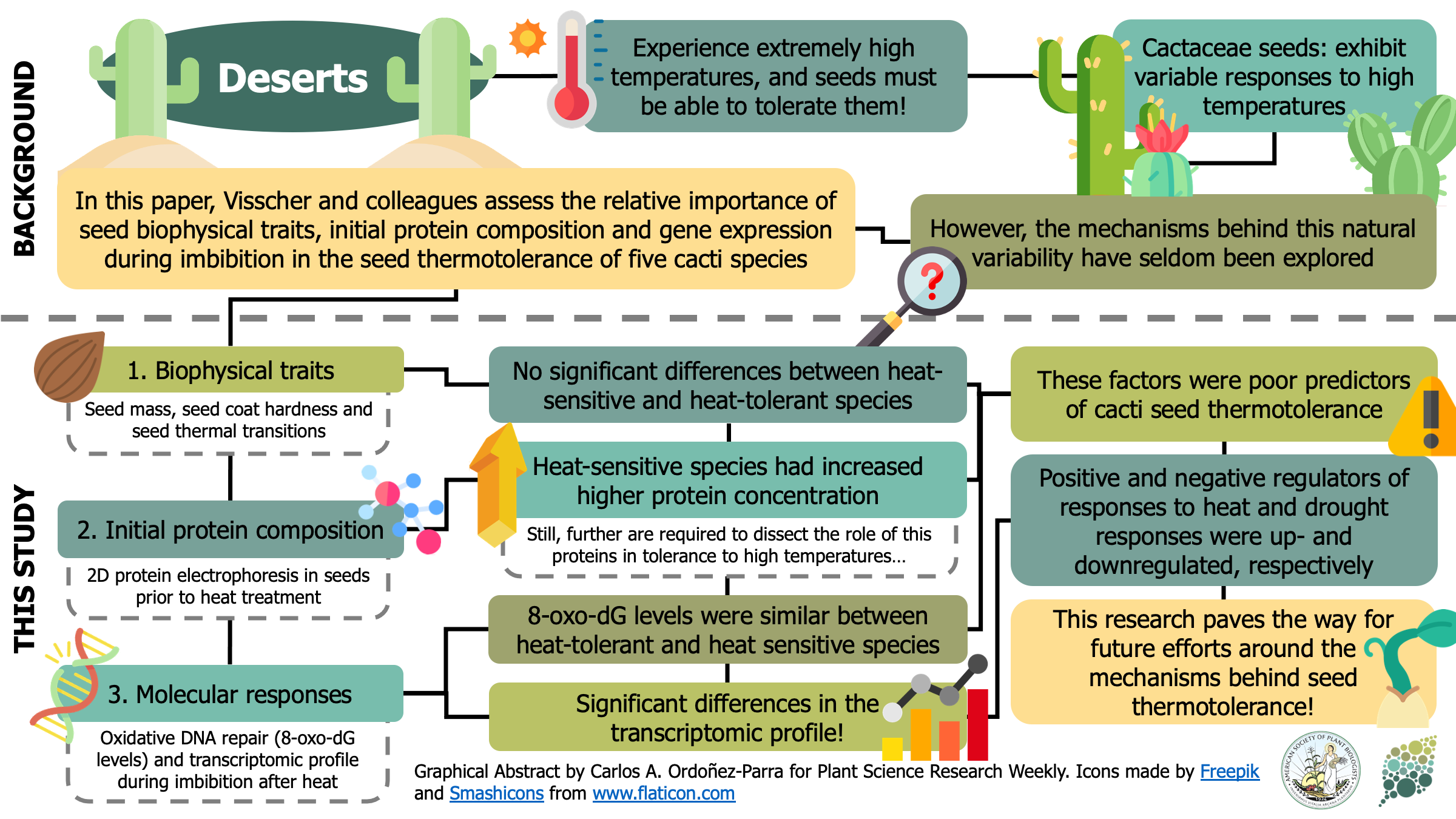 Desert plants must produce seeds that can withstand incredibly high temperatures. Nevertheless, different species of cacti –one of the most emblematic plant groups of these ecosystems– exhibit variable responses to extreme temperatures. In this fascinating paper, Visscher and colleagues conduct a thorough characterization of the seeds of five Cactaceae species with variable thermotolerance to assess the potential contribution of different traits and molecular processes to this variation. Biophysical traits (i.e., seed mass, seed coat hardness and glass transition patterns) and initial protein concentration were poor predictors of seed thermotolerance. Moreover, the levels of 8-oxo-2′-deoxyguanosine (an enzyme involved in oxidative DNA damage repair) were statistically similar between heat-sensitive and heat-tolerant species exposed to heat. As a result, these properties and processes seem to have minor contributions to seed thermotolerance. To further address the molecular underpinnings of thermotolerance, the authors carried out a transcriptomic analysis of seeds that were heat-treated when dry, with RNA isolated following imbibition. Notably, heat-tolerant species had higher levels of positive regulators of heat tolerance (e.g., HSPs and HSFA1) and drought tolerance (CAMTA1 and ADH1). Moreover, they show lower levels of negative regulators of these responses, such as RNP1 and ZAT12. As a result, this study paves the way for future efforts around the mechanisms underpinning extreme seed thermotolerance. (Summary by Carlos A. Ordóñez-Parra @caordonezparra) Environ. Exp. Bot. 10.1016/j.envexpbot.2021.104514
Desert plants must produce seeds that can withstand incredibly high temperatures. Nevertheless, different species of cacti –one of the most emblematic plant groups of these ecosystems– exhibit variable responses to extreme temperatures. In this fascinating paper, Visscher and colleagues conduct a thorough characterization of the seeds of five Cactaceae species with variable thermotolerance to assess the potential contribution of different traits and molecular processes to this variation. Biophysical traits (i.e., seed mass, seed coat hardness and glass transition patterns) and initial protein concentration were poor predictors of seed thermotolerance. Moreover, the levels of 8-oxo-2′-deoxyguanosine (an enzyme involved in oxidative DNA damage repair) were statistically similar between heat-sensitive and heat-tolerant species exposed to heat. As a result, these properties and processes seem to have minor contributions to seed thermotolerance. To further address the molecular underpinnings of thermotolerance, the authors carried out a transcriptomic analysis of seeds that were heat-treated when dry, with RNA isolated following imbibition. Notably, heat-tolerant species had higher levels of positive regulators of heat tolerance (e.g., HSPs and HSFA1) and drought tolerance (CAMTA1 and ADH1). Moreover, they show lower levels of negative regulators of these responses, such as RNP1 and ZAT12. As a result, this study paves the way for future efforts around the mechanisms underpinning extreme seed thermotolerance. (Summary by Carlos A. Ordóñez-Parra @caordonezparra) Environ. Exp. Bot. 10.1016/j.envexpbot.2021.104514
A bacterial effector targets a plant iron sensing protein, and benefits pathogen growth
 Pathogens often appropriate iron from their hosts, as acquisition of iron is vital to sustain life for most organisms. As demonstrated in this paper by Xing et al., an effector protein, AvrRps4, from a common bacterial plant pathogen, Pseudomonas syringae, directly interacts with BRUTUS (BTS), an iron sensing protein in Arabidopsis thaliana. In iron sufficient conditions, BTS prevents over-accumulation of iron by degrading transcription factors (TFs) responsible for iron import. When challenged with AvrRps4, plants heterologously co-expressing BTS and these TFs show increased apoplastic iron levels, as AvrRps4 prevents TF degradation by BTS. In wildtype plants, which are capable of recognizing and responding to AvrRps4, challenge with the effector triggers immune responses and results in lowered iron availability. AvrRps4 is sensed by its receptor pair in planta, and an immune response is mounted through the Enhanced Disease Susceptibility1 (EDS1) protein family, a well-characterized receptor involved in effector triggered immunity. However, in mutants which lack AvrRps4 receptors or EDS1, AvrRps4 is free to inhibit the regulatory function of BTS, resulting in increased apoplastic iron levels and allowing pathogen proliferation. Another function of BTS is to stabilize EDS1 protein levels in planta; BTS upregulates EDS1 in response to AvrRps4. Together these findings show that AvrRps4 targets BTS, which is involved in iron homeostasis as well as resistance to AvrRps4. (Summary by Marlo Hall @marloXplants). Plant Cell 10.1093/plcell/koab075
Pathogens often appropriate iron from their hosts, as acquisition of iron is vital to sustain life for most organisms. As demonstrated in this paper by Xing et al., an effector protein, AvrRps4, from a common bacterial plant pathogen, Pseudomonas syringae, directly interacts with BRUTUS (BTS), an iron sensing protein in Arabidopsis thaliana. In iron sufficient conditions, BTS prevents over-accumulation of iron by degrading transcription factors (TFs) responsible for iron import. When challenged with AvrRps4, plants heterologously co-expressing BTS and these TFs show increased apoplastic iron levels, as AvrRps4 prevents TF degradation by BTS. In wildtype plants, which are capable of recognizing and responding to AvrRps4, challenge with the effector triggers immune responses and results in lowered iron availability. AvrRps4 is sensed by its receptor pair in planta, and an immune response is mounted through the Enhanced Disease Susceptibility1 (EDS1) protein family, a well-characterized receptor involved in effector triggered immunity. However, in mutants which lack AvrRps4 receptors or EDS1, AvrRps4 is free to inhibit the regulatory function of BTS, resulting in increased apoplastic iron levels and allowing pathogen proliferation. Another function of BTS is to stabilize EDS1 protein levels in planta; BTS upregulates EDS1 in response to AvrRps4. Together these findings show that AvrRps4 targets BTS, which is involved in iron homeostasis as well as resistance to AvrRps4. (Summary by Marlo Hall @marloXplants). Plant Cell 10.1093/plcell/koab075
Crop origins explain variation in global agricultural relevance
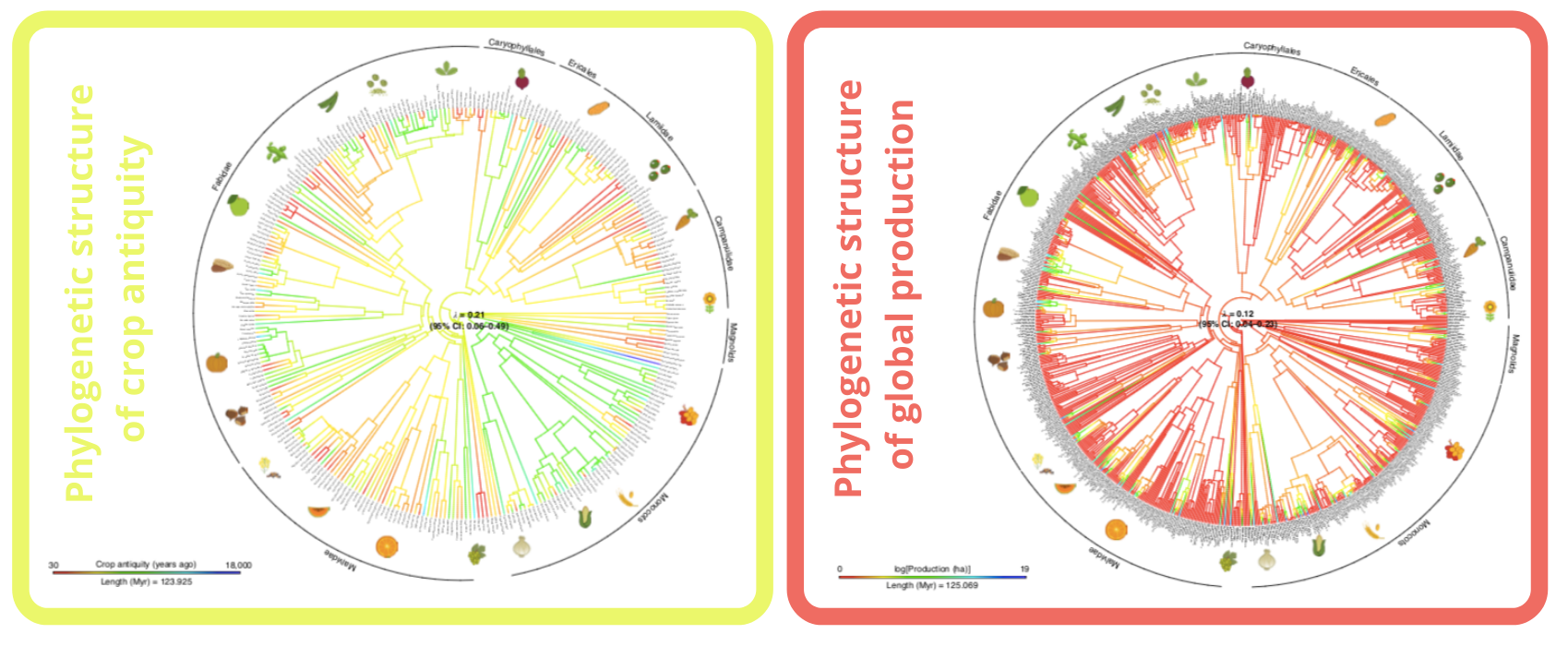 According to FAO, only a hundred out of several thousands edible plants contribute to the global food system. Specifically, twelve species dominate food production worldwide; more than a half of our daily calorie intake comes from four seed crops (maize, soybean, rice and wheat). Although the agricultural relevance of a crop largely associates with its nutritional value, plants with similar nutritional profiles nevertheless have huge differences in the extent of their production. So, which are the factors that have restricted our diets to a few major crops? To answer this question, Milla and Osborne analyzed 866 food plants and compared their origins and usage with their global production. The authors discovered that crop type and climate of origin strongly influence agricultural production worldwide. For example, crops originated in dry and seasonal climates have wider cultivation than those originated in wet and aseasonal climates, likely because the former better adjust their growth to different agroecosystems. They also found a positive correlation between crop antiquity and modern agricultural relevance. Indeed, the most cultivated seed crops were among the first domesticated plants during the transition from hunter-gatherer societies to agricultural economies. These “older” crops had longer periods of diversification and environmental adaptation, which can explain their wider geographic distribution. Agricultural homogenization was beneficial under past periods of ecological stability, but represents a risk for food security in the near future; the extensive use of monocultures and the present biodiversity crisis are leading to an impoverished agricultural system with reduced climate resilience and increased instability. Summary and image adaptation by (Michela Osnato @michela_osnato) Nature Plants 10.1038/s41477-021-00905-1
According to FAO, only a hundred out of several thousands edible plants contribute to the global food system. Specifically, twelve species dominate food production worldwide; more than a half of our daily calorie intake comes from four seed crops (maize, soybean, rice and wheat). Although the agricultural relevance of a crop largely associates with its nutritional value, plants with similar nutritional profiles nevertheless have huge differences in the extent of their production. So, which are the factors that have restricted our diets to a few major crops? To answer this question, Milla and Osborne analyzed 866 food plants and compared their origins and usage with their global production. The authors discovered that crop type and climate of origin strongly influence agricultural production worldwide. For example, crops originated in dry and seasonal climates have wider cultivation than those originated in wet and aseasonal climates, likely because the former better adjust their growth to different agroecosystems. They also found a positive correlation between crop antiquity and modern agricultural relevance. Indeed, the most cultivated seed crops were among the first domesticated plants during the transition from hunter-gatherer societies to agricultural economies. These “older” crops had longer periods of diversification and environmental adaptation, which can explain their wider geographic distribution. Agricultural homogenization was beneficial under past periods of ecological stability, but represents a risk for food security in the near future; the extensive use of monocultures and the present biodiversity crisis are leading to an impoverished agricultural system with reduced climate resilience and increased instability. Summary and image adaptation by (Michela Osnato @michela_osnato) Nature Plants 10.1038/s41477-021-00905-1



